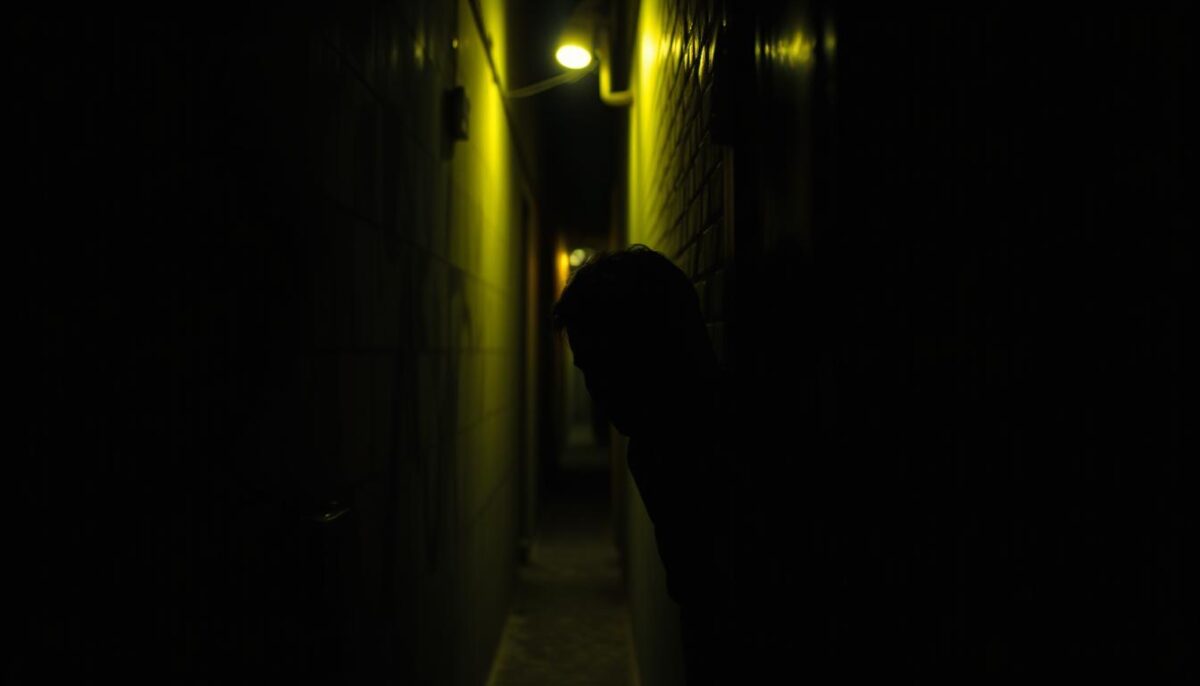The new voyeurism law, especially voyeurism under section 77 of BNS, is a big step for India. It aims to protect privacy rights. This law is a response to growing awareness of the harm caused by spying without consent.
This law shows India’s commitment to keeping personal lives private. Privacy and dignity are key to our well-being.

This law has big implications for victims and how we see privacy in India. It’s also a challenge to implement, given India’s history with voyeurism laws. For more on privacy and related topics, check out this article.
Lastly, we’ll look at how India’s new law compares to global efforts. It’s important to build a society based on consent and respect. Everyone’s autonomy matters.
Our discussion will also touch on the evolution of Indian laws, especially on privacy. We’ll look at recent updates on the Bharatiya Nyaya Sanhita (BNS).
Understanding Voyeurism: Definitions and Context
The term voyeurism means getting sexual pleasure from watching people without their okay, especially in private. This act of privacy invasion raises big ethical questions. It also has roots in how society views secret watching and personal space. In India, laws now tackle voyeurism under the Bharatiya Nyaya Sanhita, defining and penalizing such behavior.
In India, what’s seen as okay to watch and what’s not can vary a lot. Things like age, gender, and social norms play a big role. People’s views on peeping can swing from making light of it to strongly disapproving, showing the need for clear consent and privacy understanding.
It’s key to grasp what voyeurism is and its legal side. Learning about what’s okay and what’s not can make places safer. It helps people respect others’ privacy and understand the role of consent in any interaction.
| Aspect | Description |
|---|---|
| Definition of Voyeurism | Gaining sexual pleasure from observing individuals without consent |
| Legal Context in India | Addressed under the Bharatiya Nyaya Sanhita |
| Cultural Perspectives | Varies based on societal norms and individual perceptions |
| Importance of Awareness | Promotes understanding of boundaries regarding privacy and consent |
The Impact of Voyeurism in Indian Society
Voyeurism in India deeply affects both victims and the community. The rise in digital technology has made privacy invasion easier. With 750 million internet users and 650 million smartphone users, privacy is at risk.
Cybercrime cases have jumped by 24.4% from last year. This shows we need to think deeply about this issue.
Victims often feel distressed, violated, and scared. These feelings can last a long time. In India, some see voyeurism as minor or acceptable.
This view makes voyeurism more common. We need to change how we see privacy.
We should talk more about respecting personal boundaries. Learning about consent and privacy can change how we view individual rights. It’s important to empower victims and create a safer place.
We must work together to protect everyone’s right to privacy. This is our responsibility.
The New Law Cracking Down on Voyeurism in India
Section 77 of the BNS is key in India’s fight against voyeurism. It clearly defines and punishes non-consensual observation and recording. This law aims to make India a safer place for everyone.
Recently, a 21-year-old engineering student was arrested for filming in a women’s washroom. This incident shows why laws against voyeurism are so important. They help protect people’s privacy and stop offenders.
Section 77 of BNS shows India’s strong commitment to privacy. It considers the harm caused to victims and the safety of women. This law marks a big change in how India deals with voyeurism, making consent key.
Legal changes are vital for a safer society that values privacy. This law does more than punish; it helps change how we see voyeurism. Section 77 is a key part of the fight against privacy invasions, leading to a more respectful society.
What Constitutes Voyeurism Under Section 77 of BNS
The definitions of voyeurism under Section 77 of the BNS are key. They show what the law sees as voyeuristic behavior. This section talks about specific actions that are considered voyeuristic. It also explains how these acts differ from other crimes.
Private acts are a big part of this. These are actions where someone expects to be alone. Examples include:
- Exposure of genitals, posterior, or breasts in a private setting.
- Using a lavatory.
- Doing sexual activities not meant for public.
Another part of voyeurism is unauthorized surveillance. This is when someone records private acts without permission. It’s also against the law to share images taken with consent without asking first. This shows how serious the law is about privacy.
It’s important to be clear about what’s against the law. The law makes a clear difference between voyeurism and other crimes. For example, sharing images without consent is a big deal, even if they were taken with permission. This helps protect our privacy and dignity.
The punishments for voyeurism are tough. A first-time offender could face up to three years in jail and a fine. If it happens again, the penalties get even worse. This shows how serious the law is about keeping our privacy safe.
| Conviction Type | Imprisonment Term | Fine | Bail Status |
|---|---|---|---|
| First Conviction | 1-3 Years | Yes | Bailable |
| Second or Subsequent Conviction | 3-7 Years | Yes | Non-bailable |
Knowing about voyeurism and its penalties is important. It helps protect our rights and teaches us about the dangers of unauthorized surveillance. This knowledge makes our society safer by reminding us of our privacy rights.
Legal Framework Governing Privacy Invasion in India
In India, privacy rights are protected by a detailed legal framework. This includes many laws and the Constitution. Recently, Bill No. 121 of 2023 brought big changes to these laws. Section 77 of the Bharatiya Nyaya Sanhita now tackles voyeurism, a big issue today.
This new law sets out rules for different crimes, like voyeurism, sexual harassment, and stalking. It aims to stop these crimes by setting harsh penalties for offenders. This way, those who invade privacy will face serious consequences.
Looking back, India’s need to tackle privacy invasion is clear. In 2019, there were 2,419 voyeurism cases, up from 1,393 in 2018. Maharashtra and Delhi saw the most cases. Laws like the Information Technology (IT) Act of 2000 have been updated to fight cybercrimes that harm privacy. Section 66E of this act makes sure violators are punished hard, showing India’s dedication to privacy protection.
Even with these laws, there are still challenges. Many people don’t know their privacy rights well. Only 144 voyeurism complaints were made to the National Commission for Women. This shows we need to do more to teach people about privacy laws and protect everyone’s rights.
Voyeurism under Section 77 of BNS: Key Provisions and Penalties
Section 77 of the BNS sets strict rules to stop voyeurism in India. The punishment for voyeurism depends on how serious and often the crime is. First-time offenders face one to three years in jail and a fine.
For those caught again, the jail time goes up to seven years. This shows how seriously the law views this crime.
This law also makes it illegal to share images without consent. This is a big deal and can lead to serious legal trouble. Unlike some crimes, voyeurism can’t be settled privately. This means every case must be tried in court.
Trials for voyeurism happen in the Court of Session. This shows how important these cases are. The law also lets police arrest suspects without a warrant. This helps protect victims and bring justice quickly.
| Offense | First Conviction | Subsequent Convictions | Nature of Offense |
|---|---|---|---|
| Voyeurism | Imprisonment: 1 to 3 years, Fine applicable | Imprisonment: 3 to 7 years, Fine applicable | Bailable (First offense), Non-bailable (Subsequent), Non-compoundable |
| Non-Consensual Sharing | Imprisonment: Same as above | Imprisonment: Same as above | Cognizable offense |
These laws aim to punish wrongdoers and stop others from committing the same crime. They send a clear message about the importance of consent and privacy.
The Role of Law Enforcement in Enforcing Section 77
The implementation of voyeurism law under Section 77 of the Bharatiya Nyaya Sanhita, 2023, needs strong law enforcement. This law gives a clear plan for dealing with voyeuristic crimes. Police must be trained to handle these cases with care.
They need to know the law well. This helps victims get the support they need and keeps the process fair.
Effective policing voyeurism means following set rules. This includes doing background checks and keeping records. Police must also understand how to deal with the emotional side of these cases.
This approach makes victims feel safe to report crimes. It’s important for police to be empathetic.
Section 77 has rules to make enforcing the law easier. It covers how to handle arrests and court appearances. There are also rules for searches and seizures, making sure victims’ rights are protected.
Police must also work with other areas to help solve cases. This helps keep communities safe.
Law enforcement should also focus on preventing voyeurism. They can do this by gathering information and teaching the public about their rights. Working with the community and raising awareness helps police fight voyeurism well.
The Bharatiya Nyaya Sanhita has 358 provisions in 20 chapters. This makes it easier for police to follow the law. Knowing how voyeurism laws work helps police make their procedures better.
This leads to a fairer society. Legal experts need to understand how voyeurism laws fit into criminal law. This is key for effective advocacy and enforcement.
For more on this, see how the implementation of voyeurism law works with criminal law.
Victims’ Rights and Legal Recourse Against Voyeurism
Section 77 under the new Bharatiya Nyaya Sanhita has changed how victims of voyeurism are treated. It makes sure their voices are heard and their experiences are validated. Now, victims’ rights are better protected, leading to stronger legal actions against voyeurism.
It’s also important to recognize male victims. They have faced big barriers in the past. This change is a big step towards including everyone.
It’s crucial to have an easy way for victims to report incidents. They can use special helplines or go straight to the police. This makes it easier for victims to get help and for more people to speak out.
Many men, about 20.4%, have been sexually violated but don’t report it. This shows how important it is to make it easier for them to seek help.
- Support for victims includes counseling services and legal aid to navigate the often-complex judicial system.
- A witness protection scheme is mandatory, enhancing safety and cooperation during legal proceedings.
- Public awareness initiatives are rising, striving to dismantle societal taboos that deter victims from reporting offenses.
Even with progress, male victims of voyeurism still face many challenges. They often don’t report because they fear being seen as weak or ridiculed. It’s important to fight these stigmas and support victims’ rights.
With over 2,000 voyeurism cases in 2021, we need strong support systems and legal actions for victims. We must keep working to make sure all victims can seek justice.
As we move forward, we must ensure all victims feel empowered to pursue justice. We need to create an environment where their rights are not just recognized but actively protected.
Comparative Analysis: Laws Against Voyeurism Worldwide
Voyeurism laws vary worldwide, with some countries having strict rules and others being more lenient. The United States and Canada have detailed laws that cover digital voyeurism. These laws focus on consent and privacy, unlike India’s recent laws.
In comparisons with India, the UK has a clear legal structure. UK laws specifically target voyeurism, covering hidden cameras and digital spying. India’s laws, on the other hand, are still evolving and face criticism.

Australia has strong laws against voyeurism, with specific penalties for privacy breaches. These laws serve as a model for other countries. They show the importance of regularly updating laws to match changing social values.
Many countries have strict voyeurism laws, but India’s laws are still changing. Understanding these international legal frameworks helps improve India’s laws. This could lead to better privacy protection.
| Country | Laws Implemented | Key Features |
|---|---|---|
| USA | State-specific laws on voyeurism | Incorporates digital voyeurism and consent as critical elements |
| UK | Protection of Freedoms Act 2012 | Explicit provisions for covert recordings and privacy breaches |
| Australia | State statutes against voyeurism | Covers various behaviors including hidden surveillance and penalties for violations |
| India | Section 77 of the Bharatiya Nyaya Sanhita | Recent reform reflects modern definitions but has room for improvement |
Understanding Covert Monitoring and Its Legal Implications
Covert monitoring is a big topic in India’s privacy law. It often makes people wonder about the legal implications of surveillance on personal rights. Some monitoring is okay, like in workplaces. But other kinds are not and can be seen as illegal voyeurism.
In India, knowing what’s okay and what’s not is key. Laws like The Indian Penal Code and The Information Technology Act help. They say when monitoring is okay and when it’s not. Monitoring without permission can lead to big legal problems.
| Aspect | Lawful Monitoring | Illegal Voyeurism |
|---|---|---|
| Definition | Monitoring with informed consent | Surveillance without knowledge or consent |
| Legal Framework | Governed by employment and privacy laws | Penalized under voyeurism laws and privacy violations |
| Consequences | Accountability and contractual obligations | Criminal charges, penalties, and civil suits |
Keeping security and privacy in balance is hard. A study showed how surveillance tech is sometimes misused. This is especially true in cases of online harassment against women in public life. It’s a big worry about who’s watching and why.
Exploring covert monitoring and its legal side is important. It helps protect privacy rights as concerns about secret watching grow. We need to stop misuse of surveillance tech to build a fair society.
Challenges in Implementing the New Voyeurism Law
The new Section 77 of the Bharatiya Nyaya Sanhita (BNS) is a big step forward in fighting voyeurism in India. But, there are many implementation challenges that could hinder its success. People’s views on privacy and sexual crimes can make victims shy away from reporting.
Many fear being judged or not believed. This makes it hard to know how common voyeurism is. Without enough reports, it’s tough to understand the problem’s scope.
Law enforcement also faces big hurdles. Even though voyeurism is a serious crime, police need to be careful and well-informed. They must have the right training and tools to handle these cases well.
The law is strict, with penalties like up to seven years in jail for repeat offenders. This shows how serious the law is.
How judges interpret these laws is another challenge. With laws against crimes against women and children, judges’ decisions can vary. This inconsistency can weaken the laws’ impact.
For example, the Supreme Court’s decision in a POCSO case highlights the need for clear legal guidelines in sexual offense cases.
Raising public awareness is key to overcoming these challenges. It’s important to educate people about the rights of victims and the details of the voyeurism law. This change in society will help victims and make enforcing the law more effective.
| Aspect | Details |
|---|---|
| Victim Hesitance | Fear of stigma often leads to underreporting |
| Law Enforcement | Need for specialized training and sensitivity |
| Judicial Interpretation | Consistency across cases required for effective implementation |
| Public Awareness | Essential for victim support and systemic effectiveness |
Social Awareness and the Importance of Consent
Creating a society that values personal space begins with consent education. It’s key to fight voyeurism by teaching about consent. This education helps build a culture where consent is a priority in all interactions.
Starting educational programs on consent can lead to big changes. Schools and groups should teach about consent in various settings. This education fights harmful norms and empowers victims to speak up.
Here are ways to boost social awareness:
- Workshops and seminars on consent and personal boundaries.
- Working with local groups for youth outreach.
- Using media to share consent stories and facts.
Also, adding consent to school subjects makes it a normal topic. This method increases awareness and gives people the power to stand up for their rights and others.

In short, raising social awareness about consent is vital. It shapes how we see and act against voyeurism. By focusing on consent education, we build a society that respects everyone. This leads to the societal change needed to protect people from harm.
Future Implications of Section 77 on Privacy Rights in India
Thinking about the future of privacy rights in India with Section 77 of the Bharatiya Nyaya Sanhita (BNS) is exciting. This law changes how we see consent and privacy. It makes privacy rights fair for everyone, not just based on gender.
But, making these changes work needs strong law enforcement and society’s support. We must all help victims of voyeurism. This way, we protect everyone’s privacy, making our culture more respectful.
Looking ahead, we need to keep improving privacy laws as technology grows. I hope Section 77 helps us build a safer, more respectful society. Where everyone’s privacy is respected and valued.
